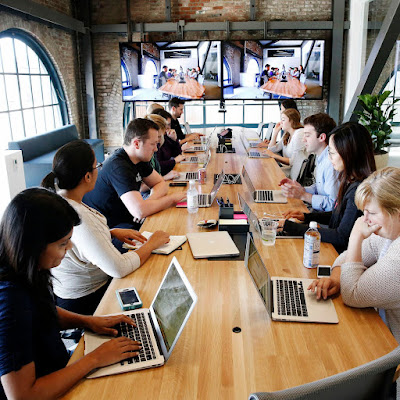Workers in the office collaborate with
virtual peers at American Express
From curbside pickup to having groceries
delivered, the COVID-19 pandemic changed many norms in American society,
including what it means to be on the job.
“It's been that catalyst that transformed
how we work. It's changed the acceptability of working at home,” says Timothy
Golden, professor of management at Rensselaer Polytechnic Institute in New
York. "Employee expectations and the norms for employees have been altered
by this experience of mass remote work.”
In the three-plus years since the pandemic
forced many to work from home, remote work has transformed from a temporary
arrangement to a new way of living and working. More than one-third of
Americans, 34%, worked from home at least some of the time in 2022, according to
the U.S. Department of Labor. By comparison, just 24% of people teleworked in
2019, before the pandemic.
Many major companies such as Amazon, Apple,
Meta [Facebook] and Disney have called workers back into the office for at
least part of the week. In October 2022, bank and financial holding company
Goldman Sachs said that more than two-thirds of its staff were back in the
office full-time.
Organizational psychologist Cathleen Swody
says her corporate clients are mostly settling on a hybrid schedule where
workers are in the office about three days a week.
“I am hearing a lot of pushback from
employees against the mandatory full-time, back-to-work option,” says Swody, a
managing partner at Thrive Leadership. “They feel that they've been working
from home for three years. They've been demonstrating their performance and
that they're trustworthy, and that they can actually get their work done
without being on site. And now they feel a little bit like that’s being called
into question.”
Golden, who has studied the issue for more
than 20 years, says remote work highlights an ever-present tension between
managers and employees.
“Remote work brings to the surface a lot of
these classic issues in management thought, in terms of control versus
autonomy,” Golden says. “Managers have a sense that maybe, somehow, they have
less control over their employees because they can't physically observe them
all the time. And so, that's uncomfortable for many managers.”
McKinsey and Company, a management
consulting firm, surveyed 25,000 Americans in the spring of 2022 and found
that 58% reported having the opportunity to work from home at least one
day a week, while 35% said they could work from home five days a week.
Eighty-seven percent of people who have the option to work from home take
advantage of the opportunity, the survey said.
“A majority of what we're talking about is
some combination of one, two, three days per week working from home. It's not
fully remote,” says Ryan Luby, an associate partner at McKinsey & Company.
“The implication of that is that folks tend to live within a reasonable
commuting radius of their offices. …You're still going to be what we think
about as tethered to an urban core.”
Having the flexibility to work remotely is
more valuable than money to some employees, according to Luby, which could help
boost employers' bottom line.
“It looks like folks are willing to exchange
wage growth for the opportunity to work flexibly,” Luby says. “And I think, in
a world in which wages are increasing rapidly and employers are concerned about
wage growth, I think there's an interesting opportunity … to think about
granting flexibility.”
Employers might not have much of a choice.
The newest entrants into the job market — recent college graduates — are
beginning their careers with different expectations than previous generations.
“They have begun the world of work with the
presence of remote work … and so, that's what they know. And in large ways,
that's what they have come to expect,” Golden says. “And so, when they look for
career opportunities and job opportunities, they look for remote work as an
option. Maybe not full time, maybe as a hybrid form.”
The experts agree that there’s almost no
chance of going back to the office full time for the majority of workers who
were able to telework during the pandemic.
“The horse has been let out of the barn. We
have experience. We have demonstrated that the technology can work, that we can
be effective not being in the office full time. And we've seen a lot of perks
for employees and for work-life management, flexibility for organizations,”
Swody says. “I think it's going to be very hard to go back to where we were.”
Photo Credit: American Express via AP Images
From VOA

.jpg)